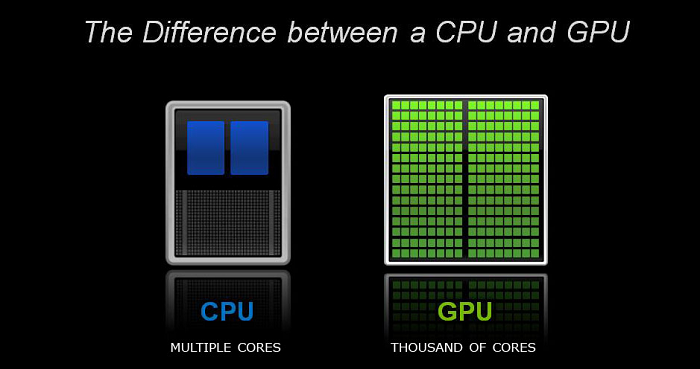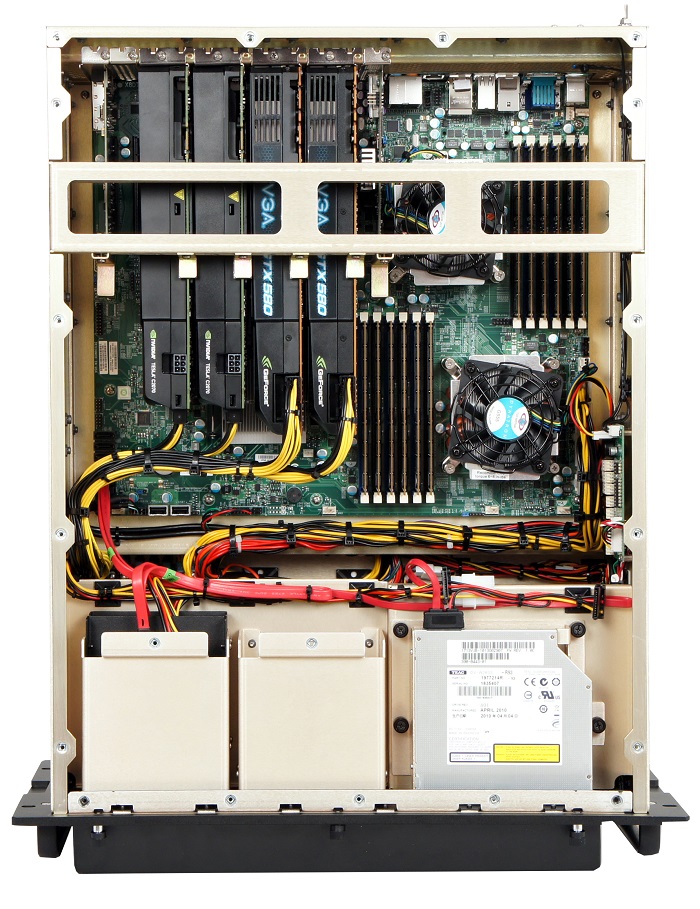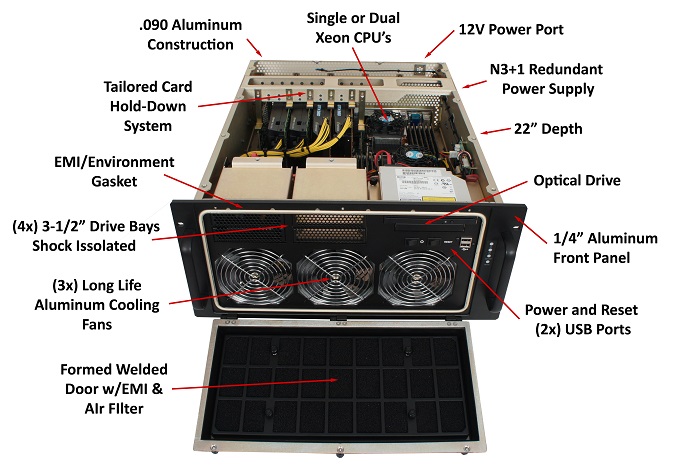By Steve Travis, Technical and Commercial Adviser, Chassis Plans
Over the years, there has been a growing need from the military for high-performance computing (HPC) platforms. In the past, data collection activities that generate petabytes of data, such as satellite imaging or unmanned aerial vehicle (UAV) sensor feeds, could require several hours to days for processing or were sent and processed at a far-off location, losing valuable time. By supplying parallel-processing techniques for solving complex computational problems in a ruggedized platform, the HPC computer can be deployed to “in-theater” locations, and it has revolutionized data capture and analysis for today’s warfighter.
High-performance computing (HPC) leverages parallel rather than serial processing for running advanced software application programs. It’s used to solve advanced mathematical calculations and perform data processing by using computer modeling, simulation, and analysis. HPC systems deliver sustained performance through their unique synchronal parallel-processing capabilities.
Most HPC systems are built around a single- or dual-CPU and one or more graphics processing units (GPUs). The GPUs play a critical role in HPC performance because they can take on the most extreme computation, leaving the CPU to do the behind-the-scenes work of running the operating system and basic system applications.

Core differences between a CPU and GPU: Each GPU can provide hundreds, or even thousands, more cores than a typical multi-core processor.
CPUs are made up from several cores that are best utilized for serial processing, while GPUs contain thousands of small cores that are designed for processing threaded data in a large-scale parallel architecture. Each of these cores can process small chunks of data in parallel with the thousands of other cores at the same time. Complex mathematical calculations can be broken down, solved, and then recombined exponentially faster than a serial multi-core-based CPU computer. When combined with software written to take advantage of parallel processing, performance increases over serial processing can range anywhere from 12× to 40× and higher.

The new Chassis Plans ruggedized rackmount 5U enclosure can support up to 4× NVIDIA Tesla GPUs in a single package for high-performance graphic processing.
Key advantages:
- Geospatial intelligence: Using specifically designed software and an HPC system, it is possible to map large areas in seconds rather than days, as in the past. Mapping large areas such as cities involves advanced algorithms capable of extracting, representing, modeling, and interpreting satellite image features. The parallel-processing capability of a GPU-based system allows algorithms to process imagery at dramatic speeds. As an example, today’s GPU-based system and software can use satellite images to map a 200-square-mile city in detail, including all buildings and roads, in less than 20 seconds.
- Video and image processing: An extremely fast dual-CPU computer can analyze a single HD (1080p) video stream at only about 15 frames per second. By adding just one GPU to the server platform, it will accelerate the video-processing software by up to 12 times. This number can also be increased by adding additional GPUs to a computer. This boost in parallel-processing power can reduce the time required to analyze 24 hours of HD (1080p) video to under 1 hour. This enables the military to identify security threats or targets of interest at a much faster rate with more accuracy.
- Image enhancements: An HPC system can be utilized for image-enhancement applications that reveal previously hidden data in satellite or UAV images. Parallel processing allows for the use of real-time image stabilization and enhancement techniques to clean up video feeds. Having these computers deployed in the field versus having to transmit or transport data back to remote locations for further analysis adds a new dimension in which information can be processed and understood in real time.
The HPC system utilizes software for image enhancements such as orthorectification (which modifies the image for topographic relief and corrects for both the distortion of the lenses and camera tilt) and “pan sharpening,” which generates high-quality, high-resolution images by combining high-resolution black-and-white images with medium-resolution color images. Both technologies require intense mathematical processes and require super-computer-type processing power. With just CPUs alone, such processes could take several minutes to hours to complete. An HPC/GPU solution can process these algorithms up to 12× faster for orthorectification and up to 40× faster for pan sharpening compared with a CPU-only-based system.
Ruggedized HPC
For the last 18 years, Chassis Plans has designed ruggedized computers that meet military standards for field-deployable equipment. Areas of ruggedization focus on shock, vibration, temperature, and blowing sand and dust. All system enclosures are manufactured from aluminum for its strength as well as weight-saving properties. A sealable front door protects system controls and includes a field-replaceable/-cleanable air filter.
Internally, a hold-down bracket secures all GPU boards from multiple points, keeping the boards stabilized in their sockets. Cable assemblies are carefully routed to ensure that there is no chafing, and service loops are built in to avoid tension on cable connections and for maximum air-flow routing.

The new Chassis Plans M5U-22 high-performance computer is based on a ruggedized 5U enclosure that is designed to meet the environmental requirements for a wide range of ground, vehicle, shipboard, and aircraft installations.
Used to accurately control the system temperatures, Chassis Plan’s patented Syscool thermal management system consists of a thermal management board, high mean-time-between-failure (MTBF) cooling fans, and a network of thermistors that monitor the computer’s internal temperature in real time and adjust fan speeds accordingly.
SWaP advantage
SWaP, a military acronym for “size, weight, and power,” are very important product features for today’s military. By introducing the latest GPU technologies into a ruggedized platform, there are several SWaP advantages possible. All three elements of SWaP are affected by reducing the required number of deployed computers for an application, which frees up valuable rack space.
This reduction in physical computers then lowers the overall platform weight, which could mean a reduction of hundreds of pounds. Power savings also can be reduced by thousands of watts. When comparing size, weight, and power advantages, an HPC configuration is the clear winner.
With dedicated engineering and product support, Chassis Plans can provide platform solutions based on the customer’s specific application. This process begins by understanding a customer’s environmental requirements for applications ranging from ground-based vehicles and shipboard to aircraft applications.
With a variety of mechanical and electrical changes and upgrades to several COTS hardware paths available, a customer consults with the engineering team to custom-tailor a HPC solution that maximizes performance, ruggedization, and price points. The final system has a five-year warranty.
Author bio
Steve Travis serves as technical and commercial adviser for Chassis Plans, where he is responsible for marketing activities focusing on ruggedized computer and LCD display products for military and industrial applications. Steve has more than 24 years of experience as an entrepreneur, in technical sales, product management, marketing communications, and leadership roles. Steve currently resides in San Diego, California.
The article originally appeared at the Military & Aerospace Designline.
Advertisement
Learn more about Electronic Products Magazine





